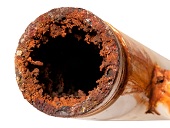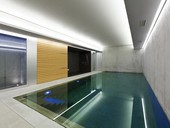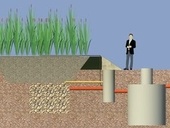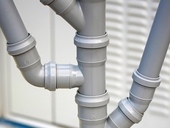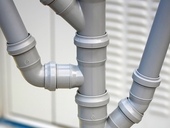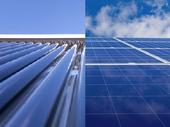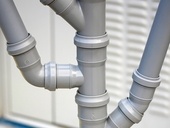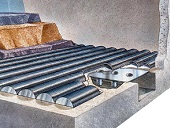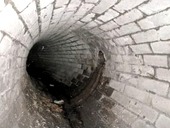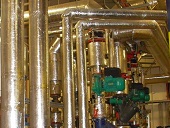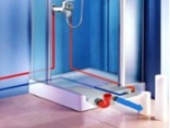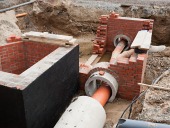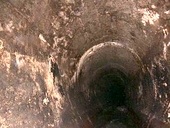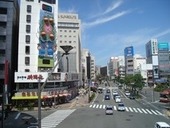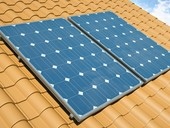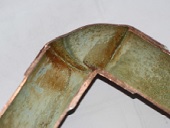The standard specifies requirements and provides recommendations for the installation of water supply systems in buildings. It is valid for new installations and for replacement and repair. The series of standards DIN EN 806 1-5 also includes the national standard ČSN 75 5409 “Internal Water Supply”.
Archiv článků od 2.12.2013 do 16.6.2014
It solves the hardness of the water, caused by the content of dissolved minerals and iron and manganese, which is mainly due to technological glitches. Water is the natural habitats of microorganisms, which include bacteria. Nitrates, which are a common and dangerous problem especially in water pumped from wells.
The main requirements in the design of the HVAC system include removal of water vapor and flue trichloramine (NCl3) from an area where swimmers. This article aims to point out the problem with the releasing trichloramines from the water and the possibility of determining the amount of evaporated water vapor from the water. In conclusion, the article points out the conflicting requirements associated with removal trichloramine and increased evaporation of water vapor from the boundary layer above the surface of the pool.
Water is the basis of all organic life on Earth. The Czech Republic is currently about 85% of the population and industrial buildings supplied with water from public water systems. The remaining part uses water from their own or public wells. Often this is due to the price of water, but often also for the security of water supply in case of loss or reduction in the quality of water supplied by public systems. An increasing number of customers who are connected to public water and also use water from their own resources.
New knowledge and technology of water treatment, corrosion learning processes and the development of chemical processes with protective products allow relatively well treated and protected water for renewed and newly constructed water sources.
The basis of a well-functioning wastewater treatment plant vegetation is growing mechanical pretreatment for maximum retention of floating and settleable solids. Following filtration wetland vegetation removal of organic contamination, pollution ammonia, phosphorus, sulfur, heavy metals and other contaminants.
In January 2014, issued a revised CSN 75 6760, which is in the Czech Republic national standards for drainage systems. The revised standard supplements the requirements of European standards EN 12056-1 to 5 and BS EN 752 and is valid from 1 February 2014. ČSN 75 6760 pays for water drainage systems, which is owned by the owner of the property and is located inside and outside buildings.
In January 2014, issued a revised CSN 75 6760, which is in the Czech Republic national standards for drainage systems. The revised standard supplements the requirements of European standards EN 12056-1 to 5 and BS EN 752 and is valid from 1 February 2014. ČSN 75 6760 pays for water drainage systems, which is owned by the owner of the property and is located inside and outside buildings.
This article focuses on the issue of creation of operating rules that pertain to the field of operational documentation. Operating rules are an essential part of the efficient operation of the property. This article is targeted to the content site of operating rules by various functional use of objects. A method of operation of the building affects the composition of future operating rules. In this article, the individual include the composition and structure defined according to the method of use of the building.
Three systems dedicated purely for heating of water - one solar thermal and two different photovoltaic - were compared under comparable climate conditions and heat consumption. The comparison was made using simulation software TRNSYS. Subsequently, based on several bids, economic comparison of the three systems was made.
In January 2014, issued a revised CSN 75 6760, which is in the Czech Republic national standards for drainage systems. The revised standard supplements the requirements of European standards EN 12056-1 to 5 and BS EN 752 and is valid from 1 February 2014. ČSN 75 6760 pays for water drainage systems, which is owned by the owner of the property and is located inside and outside buildings.
The paper describes the construction of a drainage system Triton and gives examples of its use in water treatment in the Czech Republic. In the world the system is used for over 10 years, but in our country since 2010. The first use of system Triton was at the water treatment plant Štítná nad Vláří, the other is at the water treatment plant Kroměříž.
The Optical fiber DTS (Distribution Temperature Systems) are unique distributed temperature systems using optical fiber as a sensor. For their function they use nonlinear effect in optical fiber (Raman nonlinear effect, Brillouin nonlinear effect). In its activities using the nonlinear effect in optical fibers (Raman nonlinear phenomenon Brillouin nonlinear effect).
The advantages of such a sensory system consisting of immunity to electromagnetic radiation are small, they can be safely used in flammable and explosive environments and can be easily installed.
Fiber-optic DTS can therefore be advantageously used in such environments and processes where the threat to human health or adverse frequent access. Such environments include sewer networks and associated facilities.
This article deals with the possibilities of using DTS optovláknového for locating illegal discharge of waste water into storm drains.
About 5% of the total delivered energy consumption in Germany is used for water heating. Referring to buildings, the percentage of the delivered energy consumption for domestic hot water is about 11%. Due to continuous efforts to reduce the heating demand of buildings the percentage of energy used for hot water supply will increase decisively during the upcoming years. This tremendous amount of energy in the waste water is usually discharged unused in the sewage system. In order to achieve the European objectives of climate protection waste water heat recovery provides an enormous and for the most part unexploited potential to develop resource-efficient heating devices in buildings.
In the last years, we indicated progress in use of alternative methods for drainage. Thanks to information from abroad we started designing vacuum and pressure methods of drainage instead gravity ones. The main content of this script is especially to point out deficiencies of nowadays used alternative methods for drainage which we can defuse. Another important part is also the design of suitable technical indicators describing these drainages.
Field of study trenchless technology is historically one of the newest building industries. Selection of a suitable methods rehabilitation of the sewer network these technologies must be based on perfect knowledge the technical and operational network conditions, monitored by the operator. For this reason it is necessary to first make categorization of damages in the pipe and then may select trenchless technology suitable for the case. It is advisable to connect the draft environmental assessment technologies and the impact of wastewater on the condition and service life the sewer network.
Standard CSN 73 4108 Sanitary facilities and changing rooms from February 2013 applies to renewals and enhancements and changes in use of buildings; does not apply to equipment in residential buildings (see CSN 73 4301), a medical and treatment plants and for designing special locker, which, due to operation require special solutions.
This article describes a photovoltaic generator used for water heating and compares it with the well known solar thermal system. Photovoltaic modules can be connected to the load both directly or via a regulator that tracks the maximal power point of the modules. Measurements and simulations in meteorological conditions of Czech Republic were done to set the energy loss for a system without the regulator. It was found that without the regulator the system can deliver maximally 77 % of energy. To achieve high efficiency of the system, maximal power point tracking has to be used.
In all my articles and lectures in recent years I highlight the problems of corrosion in systems of water supply made of metal. Theoretically, we all could have idea of types of corrosion in metallic materials. In the design of water supply a lot of designers overlook this knowledge as fabrications of "pundits". Their notice about inappropriate use of galvanized steel pipe for water system aren't taken seriously.
zpět na aktuální články

